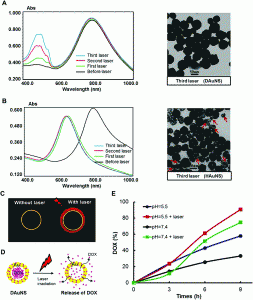As cancer therapy evolves there is a desire to explore minimally invasive treatments which are applicable to all patients, regardless of concerns with drug resistance and tumour morphology. One such option being investigated is photothermal therapy (PTT), which seeks to achieve these aims through the selective uptake of photosensitizing agents by cancerous cells prior to their abalation using a near infa-red (NIR) light source. However, currently the efficacy of PTT is reduced due to heterogeneous heat distribution, resulting in the accumulation of sub-lethal doses of the sensitizing agent within areas of the tumor.
Zhou and co-workers have sought to overcome this issue by creating a “double punch” strategy for tumour targeting using PTT. Through the implantation of hollow gold nanoshells with the chemical agent doxorubicin (DAuNS), a novel combination of a photosensitizing agent and a chemical targeting agent has been created. Furthermore, this unique, yet simple synthesis strategy is thought to be interconvertible with other drug and nanomaterial combinations, thus, widening the scope for potential PTT treatments.
Through comparisons with ‘single-strategy’ treatments of bare hollow gold nanoshells (HAuNS) or doxorubicin, the improved efficacy of the DAuNS is well established through both in-vitro and in vivo studies. This significant improvement can be attributed to the enhanced plasmon absorption in the NIR region of DAuNS in comparison to HAuNS (1.5 fold increase), with a more efficient photothermal conversion and a greater efficacy in tumor killing also established. These properties are only enhanced by the combined chemotherapeutic effect achieved through the deployment of the doxorubicin payload.
As this strategy obviates the concerns of genetic drug resistance and is a minimally invasive treatment, it could carry significant potential. This potential is only further enhanced by the ability to exchange different chemotherapeutic reagents, and as such this could be a significant breakthrough which aids future cancer therapies.
Hybridized Doxorubicin-Au Nanospheres Exhibit Enhanced Near-infrared Surface Plasmon Absorption for Photothermal Therapy Applications
Jialin Zhou, Zuhua Wang, Qingpo Li, Fei Liu, Yongzhong Du, Hong Yuan, Fu-Qiang Hu, Yinghui Wei and Jian You
Nanoscale, 2015, Advance Article. DOI: 10.1039/C4NR07279K.











